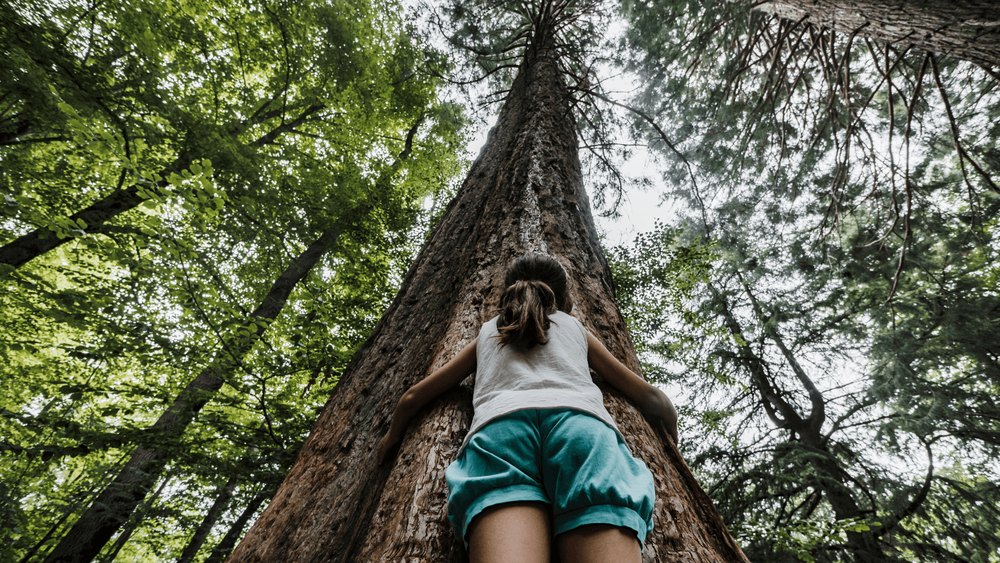Going back to our roots: The benefits of tree hugging
Imagine walking through a forest. Sunlight dappling through canopies of waving leaves. Unfurling smells of moss, cedarwood and fern. Wrap your arms around a wise old bark and allow the ineffable harmony to ensue.
The Wilder Route claims that by hugging a tree, “you release a hormone called oxytocin – known as the hormone of love, trust and all the warm & fuzzy feels.” Additionally, trees and plants emit “phytoncides”, which we breathe in when we spend time in forests. According to Dr Qing Li, phytoncides enhance the activity of natural killer cells that help our bodies fight disease.
Benefits of hugging
Hugging expert Sebastian Ocklenburg, PhD has found a strong association between hugging and health: reducing stress hormones, improving relationships, and “older people who at least occasionally get hugs tend to feel better about their health.”
Interestingly, not only is hugging others beneficial but so is hugging yourself. Ocklenburg appreciates that “there's actually a lot of diversity in hugging beyond the two-person hug.”
So how about the benefits of hugging trees? Although Ocklenburg’s research hasn’t reached trees yet, he did provide some sound explorative advice: “let yourself go into this experience, and it may be something that speaks to you. It might have a positive effect too.” It’s hard to quantify our subjective experiences, and if hugging oneself can be beneficial, isn’t it worth trying with trees?
It’s worth being extra cautious and respectful when initiating a hug, as some people and animals may find it uncomfortable or inappropriate: Ocklenburg revealed on RadioReverb that while some dogs seem happy to be embraced, some find it an act of aggression and dominance. But you know who loves to be hugged? Your local tree!
Cultures that encourage tree-hugging
During 2020’s lockdown, Iceland recommended tree hugging. Their forest rangers cleared roads of snow leading up to trees for people to embrace the benefits of connecting with trees. Is it any coincidence that they are one of the happiest nations in the world?
Norwegians are partial to friluftsliv or “outdoor life” and, as a nation, promote environmental awareness, creating a loving attitude towards nature, including tree hugging; today, nine out of ten Norwegians state that they are interested in friluftsliv.
In the 1980s, the Japanese Forestry Agency promoted Shinrin Yoku, translated as “forest bath”, which is the act of immersing ourselves in green spaces as a way to combat stress and reconnect with nature: “the practitioner must engage their five senses (sight, smell, touch, taste, hearing), at each moment of the experience.” Forest bathing has since become popular across the globe.
Politically charged origins of “treehugger”
Tree hugging has firm roots in environmental activism. The Chipko movement of the 1970’s, a nonviolent, social and ecological movement by villagers from the Chamoli district of Uttarakhand, India, mobilised mostly women to save forests from government-backed felling by hugging trees. After this initial act succeeded, the tree hugging strategy spread throughout the region. “The now-dismissive term “treehugger” in fact comes from the Chipko movement,” claims academic Haripriya Rangan.
“Chipko” means “stick to,” and the Chipko activists stuck to trees to save them. Chandi Prasad Bhatt, from the movement, said, “We will not allow the felling of ash trees. When they aim their axes on them, we will embrace the trees.” Environmental academic Thomas Crowley views the implication as creating “a deep bond between the huggers and the trees they embraced”.
Are you a tree hugger?
Tree-hugging deepens our connection with nature. It’s respite from concrete walls. It’s bathing in rhythms of rest and exploration among the fauna. A sensory reminder of playing our part in the symbiosis of humankind and nature.
Sometimes it’s about stopping bulldozers.
And if you haven’t already tried it, why not have a go? Relax into it - listen to the rustling of leaves as you press your face against an earthy trunk.
Looking for more earth-aligned ways to connect with nature, explore the benefits of animal sanctuaries with How sanctuaries affirm a vegan life and check out the essay, Mind. Being. World from author David Brooks.
